Polar Stratospheric Clouds Or PSCs, Also Known As Nacreous Clouds, Are Clouds In The Winter Polar Stratosphere

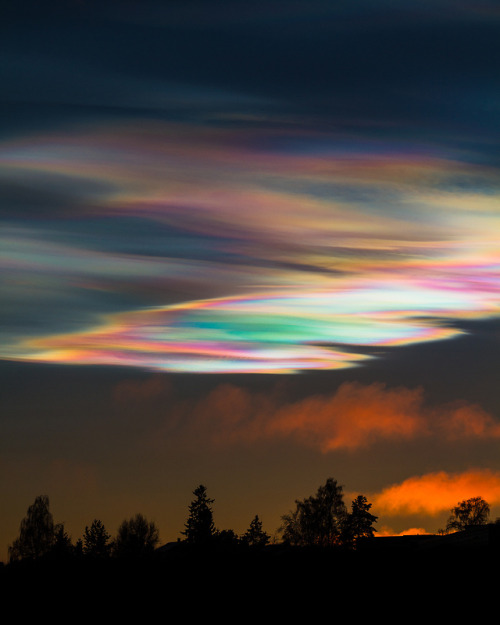
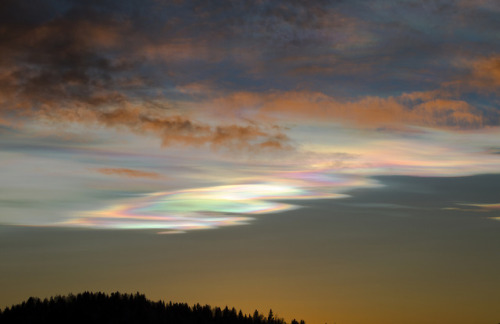

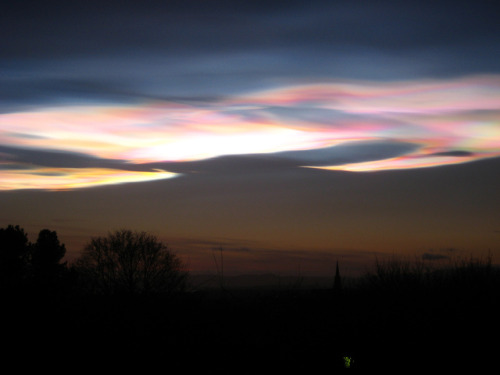


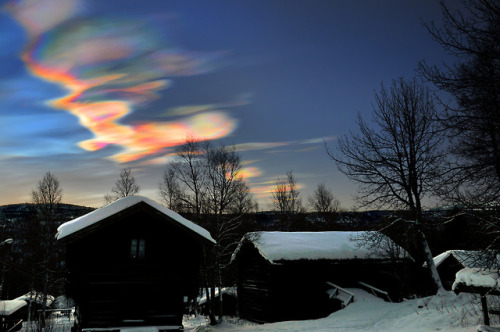
Polar stratospheric clouds or PSCs, also known as nacreous clouds, are clouds in the winter polar stratosphere at altitudes of 15,000–25,000 meters (49,000–82,000 ft). They are best observed during civil twilight when the sun is between 1 and 6 degrees below the horizon as well as in winter and in more northerly latitudes. They are implicated in the formation of ozone holes. The effects on ozone depletion arise because they support chemical reactions that produce active chlorine which catalyzes ozone destruction, and also because they remove gaseous nitric acid, perturbing nitrogen and chlorine cycles in a way which increases ozone destruction.
source / images: x, x, x, x, x, x, x, x
More Posts from Riekod and Others

After the rain of Hurricane Florence came the rainbow, or rainbows, in this case. Photographer John Entwistle captured this image of a rainbow with several additional supernumerary bows. The inner fringes seen here form when light passes through water droplets that are all close to the same size; given the spread seen here, the droplets are likely smaller than a millimeter in diameter. Supernumerary rainbows cannot be explained with a purely geometric theory of optics; instead, they require acknowledging the wave nature of light. (Image credit: J. Entwistle; via APOD; submitted by Kam-Yung Soh)


Neptune
It is named after the Roman god of the sea and has the astronomical symbol ♆, a stylised version of the god Neptune’s trident.
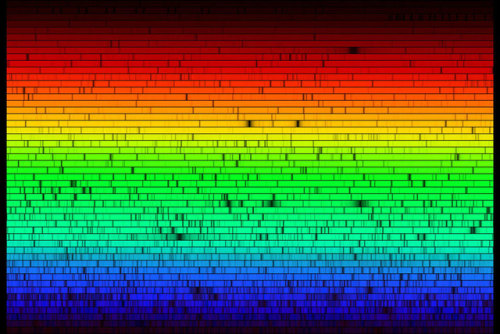
This is the visible spectrum of the light from the sun. And if you have played with white light and prisms before, it might come as a huge surprise to you to know that the spectrum from the sun is actually not continuous.

Why is it not ? The dark patches in the above spectrum arise from gas at or above the Sun’s surface absorbing sunlight emitted below.

Source
Since there are different types of gases that compose the sun, there are numerous wavelengths of light that get absorbed by these gases.

Source: xkcd
How do we know which line corresponds to which ? Well, it’s because we have a periodic table, and we know the spectrum of all the elements in it:

Source
And then it’s a matter of solving the jigsaw puzzle of fitting the spectrum with the tiles that you have. When we do so, we obtain the following composition of elements:

Source: Earth Blog
We can even take it one step further by finding the composition of other neighboring stars as well.

Source: Potsdam University
All of this information about the star can be captured from a simple spectrum. And this is why one of the most important tool that an astronomer has about an object is it’s spectrum.
Have a good one!
Edit: Added all sources for the images.
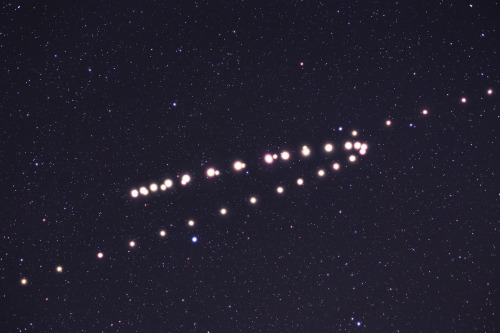
Retrograde motion of Mars in the night sky of the Earth.
Image Credit: Tunc Tezel
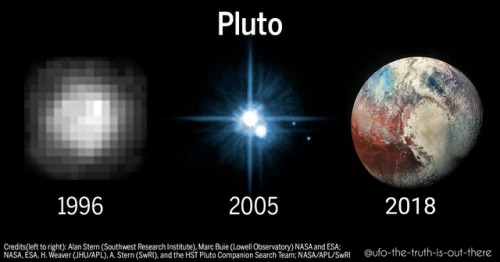
In “Float” artist Susi Sie uses water and oil to create a whimsical landscape of bubbles and droplets. Coalescence is a major player in the action, though Sie uses some clever time manipulations to make her bubbles and droplets multiply as well. Watching coalescence in reverse feels like seeing mitosis happen before your eyes. (Video and image credit: S. Sie)



As I get older I’m finding that a lot of the “intellectuals” I used to admire are actually just condescending and pretentious. And also realizing how much more important it is to be present, considerate, and empathetic because nobody really knows what they’re talking about and anyone who claims to know everything about anything is feeding you bs.
How Big is Our Galaxy, the Milky Way?
When we talk about the enormity of the cosmos, it’s easy to toss out big numbers – but far harder to wrap our minds around just how large, how far and how numerous celestial bodies like exoplanets – planets beyond our solar system – really are.
So. How big is our Milky Way Galaxy?
We use light-time to measure the vast distances of space.
It’s the distance that light travels in a specific period of time. Also: LIGHT IS FAST, nothing travels faster than light.

How far can light travel in one second? 186,000 miles. It might look even faster in metric: 300,000 kilometers in one second. See? FAST.

How far can light travel in one minute? 11,160,000 miles. We’re moving now! Light could go around the Earth a bit more than 448 times in one minute.

Speaking of Earth, how long does it take light from the Sun to reach our planet? 8.3 minutes. (It takes 43.2 minutes for sunlight to reach Jupiter, about 484 million miles away.) Light is fast, but the distances are VAST.

In an hour, light can travel 671 million miles. We’re still light-years from the nearest exoplanet, by the way. Proxima Centauri b is 4.2 light-years away. So… how far is a light-year? 5.8 TRILLION MILES.

A trip at light speed to the very edge of our solar system – the farthest reaches of the Oort Cloud, a collection of dormant comets way, WAY out there – would take about 1.87 years.
Our galaxy contains 100 to 400 billion stars and is about 100,000 light-years across!
One of the most distant exoplanets known to us in the Milky Way is Kepler-443b. Traveling at light speed, it would take 3,000 years to get there. Or 28 billion years, going 60 mph. So, you know, far.
SPACE IS BIG.

Read more here: go.nasa.gov/2FTyhgH
Make sure to follow us on Tumblr for your regular dose of space: http://nasa.tumblr.com.
![Same But Different: Spiral Galaxies NGC6935 And NGC6937 [OC] [1528x1081]](https://64.media.tumblr.com/dd6f17138995f6c47dbf66838525b36d/tumblr_pdl7zz0GTf1rcl722o1_500.png)
Same but different: Spiral Galaxies NGC6935 and NGC6937 [OC] [1528x1081]

If you dropped a water balloon on a bed of nails, you’d expect it to burst spectacularly. And you’d be right – some of the time. Under the right conditions, though, you’d see what a high-speed camera caught in the animation above: a pancake-shaped bounce with nary a leak. Physically, this is a scaled-up version of what happens to a water droplet when it hits a superhydrophobic surface.
Water repellent superhydrophobic surfaces are covered in microscale roughness, much like a bed of tiny nails. When the balloon (or droplet) hits, it deforms into the gaps between posts. In the case of the water balloon, its rubbery exterior pulls back against that deformation. (For the droplet, the same effect is provided by surface tension.) That tension pulls the deformed parts of the balloon back up, causing the whole balloon to rebound off the nails in a pancake-like shape. For more, check out this video on the student balloon project or the original water droplet research. (Image credits: T. Hecksher et al., Y. Liu et al.; via The New York Times; submitted by Justin B.)

-
 nightcoeur reblogged this · 3 months ago
nightcoeur reblogged this · 3 months ago -
 dotglobal liked this · 10 months ago
dotglobal liked this · 10 months ago -
 blackxenergy liked this · 1 year ago
blackxenergy liked this · 1 year ago -
 jupiterprincesshouou liked this · 1 year ago
jupiterprincesshouou liked this · 1 year ago -
 lyingthroughwhispers reblogged this · 1 year ago
lyingthroughwhispers reblogged this · 1 year ago -
 garnicas reblogged this · 1 year ago
garnicas reblogged this · 1 year ago -
 garnicas liked this · 1 year ago
garnicas liked this · 1 year ago -
 themightyif liked this · 2 years ago
themightyif liked this · 2 years ago -
 heylittlejess liked this · 2 years ago
heylittlejess liked this · 2 years ago -
 starstruckcycleperson liked this · 2 years ago
starstruckcycleperson liked this · 2 years ago -
 lupin5th liked this · 2 years ago
lupin5th liked this · 2 years ago -
 pin3n33dl3s reblogged this · 2 years ago
pin3n33dl3s reblogged this · 2 years ago -
 evergre3ns liked this · 2 years ago
evergre3ns liked this · 2 years ago -
 unfuckitall liked this · 2 years ago
unfuckitall liked this · 2 years ago -
 calligrafiti liked this · 2 years ago
calligrafiti liked this · 2 years ago -
 voidling-collective reblogged this · 2 years ago
voidling-collective reblogged this · 2 years ago -
 chakjoe liked this · 2 years ago
chakjoe liked this · 2 years ago -
 cho-fu-sa liked this · 2 years ago
cho-fu-sa liked this · 2 years ago -
 allsteff liked this · 2 years ago
allsteff liked this · 2 years ago -
 d1-flower liked this · 2 years ago
d1-flower liked this · 2 years ago -
 peacheowyn reblogged this · 3 years ago
peacheowyn reblogged this · 3 years ago -
 preljuba reblogged this · 3 years ago
preljuba reblogged this · 3 years ago -
 savagepooke liked this · 3 years ago
savagepooke liked this · 3 years ago -
 zoosii liked this · 3 years ago
zoosii liked this · 3 years ago -
 mermaidbrianna reblogged this · 3 years ago
mermaidbrianna reblogged this · 3 years ago -
 littlecanuck reblogged this · 3 years ago
littlecanuck reblogged this · 3 years ago -
 yourlocalhomosexualrayofsunshine liked this · 3 years ago
yourlocalhomosexualrayofsunshine liked this · 3 years ago -
 unicornmunch reblogged this · 3 years ago
unicornmunch reblogged this · 3 years ago -
 pawsteps reblogged this · 3 years ago
pawsteps reblogged this · 3 years ago -
 pawsteps liked this · 3 years ago
pawsteps liked this · 3 years ago -
 trustedroot reblogged this · 3 years ago
trustedroot reblogged this · 3 years ago -
 wickedhawtwexler reblogged this · 3 years ago
wickedhawtwexler reblogged this · 3 years ago -
 crossroadsdog liked this · 3 years ago
crossroadsdog liked this · 3 years ago